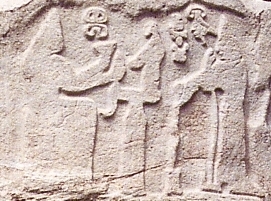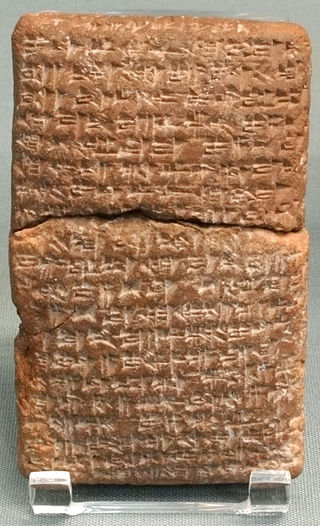Related Research Articles

The Hittites were an Anatolian people who played an important role in establishing first a kingdom in Kussara, then the Kanesh or Nesha kingdom, and next an empire centered on Hattusa in north-central Anatolia. This empire reached its height during the mid-14th century BC under Šuppiluliuma I, when it encompassed an area that included most of Anatolia as well as parts of the northern Levant and Upper Mesopotamia.

Mitanni, c. 1550–1260 BC, earlier called Ḫabigalbat in old Babylonian texts, c. 1600 BC; Hanigalbat or Hani-Rabbat in Assyrian records, or Naharin in Egyptian texts, was a Hurrian-speaking state with Indo-Aryan linguistic influences in northern Syria and southeast Anatolia. Since no histories or royal annals/chronicles have yet been found in its excavated sites, knowledge about Mitanni is sparse compared to the other powers in the area, and dependent on what its neighbours commented in their texts.

Tushratta was a king of Mitanni, c. 1358–1335 BCE, at the end of the reign of Amenhotep III and throughout the reign of Akhenaten. He was the son of Shuttarna II. Tushratta stated that he was the grandson of Artatama I. His sister Gilukhipa and his daughter Tadukhipa were married to the Egyptian pharaoh Amenhotep III; Tadukhipa later married Akhenaten who took over his father's royal harem.
Mursili I was a king of the Hittites c. 1620-1590 BC, as per the middle chronology, the most accepted chronology in our times,, and was likely a grandson of his predecessor, Hattusili I. His sister was Ḫarapšili and his wife was queen Kali.
Telipinu was the last king of the Hittites Old Kingdom, living in 16th century BC, reigned c. 1525-1500 BC in middle chronology. At the beginning of his reign, the Hittite Empire had contracted to its core territories, having long since lost all of its conquests, made in the former era under Hattusili I and Mursili I – to Arzawa in the West, Mitanni in the East, the Kaskians in the North, and Kizzuwatna in the South.
Adad-nārārī I, rendered in all but two inscriptions ideographically as mdadad-ZAB+DAḪ, meaning "Adad (is) my helper," was a king of Assyria during the Middle Assyrian Empire. He is the earliest Assyrian king whose annals survive in any detail. Adad-nārārī I achieved major military victories that further strengthened Assyria. In his inscriptions from Assur he calls himself son of Arik-den-ili, the same filiations being recorded in the Nassouhi kinglist. He is recorded as a son of Enlil-nirari in the Khorsabad kinglist and the SDAS kinglist, probably in error.
Kizzuwatna was an ancient Anatolian kingdom in the 2nd millennium BC. It was situated in the highlands of southeastern Anatolia, near the Gulf of İskenderun, in modern-day Turkey. It encircled the Taurus Mountains and the Ceyhan River. The centre of the kingdom was the city of Kummanni, in the highlands. In a later era, the same region was known as Cilicia.

Barattarna, Parattarna, Paršatar, or Parshatatar was the name of a Hurrian king of Mitanni and is considered to have reigned, as per middle chronology between c. 1510 and 1490 BC by J. A. Belmonte-Marin quoting H. Klengel.

Hantili I was a king of the Hittites during the Hittite Old Kingdom. His reign lasted for 30 years, from c. 1590 to c. 1560 BC.
Zidanta I was a king of the Hittites, ruling for 10 years, ca. 1560–1550 BC or 1496–1486 BC. According to the Telepinu Proclamation, this king became a ruler by murder.

Çukurova or the Cilician Plain, is a large fertile plain in the Cilicia region of southern Turkey. The plain covers the easternmost areas of Mersin Province, southern and central Adana Province, western Osmaniye Province and northwestern Hatay Province.

The Luwians were an ancient people in Anatolia who spoke the Luwian language. During the Bronze Age, Luwians formed part of the population of the Hittite Empire and adjoining states such as Kizzuwatna. During the Hittite New Kingdom, Luwian replaced Hittite as the empire's dominant language. In the early Iron Age, a number of Luwian-speaking Neo-Hittite states arose in northern Syria. The Luwians are known largely from their language, and it is unclear to what extent they formed a unified cultural or political group.

Puduḫepa or Pudu-Kheba was a Hittite queen, married to the King Hattusili III. She has been referred to as "one of the most influential women known from the Ancient Near East."
Isputahsu was a king of Kizzuwatna, probably during the mid 15th century BC. He signed a treaty of alliance with the Hittite king Telepinu.

Pilliya was a king of Kizzuwatna ca. the 15th century BC. He signed a treaty with Idrimi of Alalakh, allying with the Mitanni empire.
Tahurwaili was a king of the Hittites, c. early 15th century BC or mid 15th century BC. He was a cousin of the King Telipinu.
Hantili II was a king of the Hittites in the 15th century BC.

The prehistory of Anatolia stretches from the Paleolithic era through to the appearance of classical civilisation in the middle of the 1st millennium BC. It is generally regarded as being divided into three ages reflecting the dominant materials used for the making of domestic implements and weapons: Stone Age, Bronze Age and Iron Age. The term Copper Age (Chalcolithic) is used to denote the period straddling the stone and Bronze Ages.

Ḫarapšili was a Hittite queen during the Old Kingdom of Hittites.
Urshu, Warsuwa or Urshum was a Hurrian-Amorite city-state in southern Turkey, probably located on the west bank of the Euphrates, and north of Carchemish.
References
- ↑ "Kingdoms of Anatolia" . Retrieved April 28, 2011.